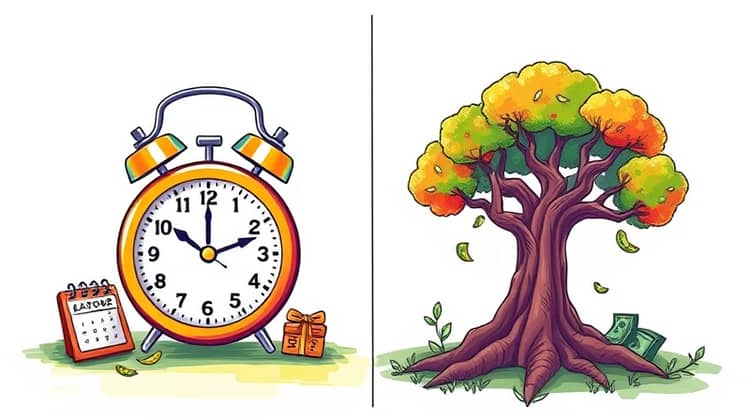When it comes to choosing an insurance plan, many individuals find themselves torn between term life and whole life insurance. Both types of policies serve the primary purpose of providing financial security, but they do so in significantly different ways. Understanding these differences is crucial for making an informed decision that aligns with your financial goals and personal circumstances.
Term life insurance offers coverage for a specific period, while whole life insurance provides lifetime coverage and a cash value component. This article aims to clarify the fundamentals of both insurance types, their advantages and limitations, and guide you on how to choose the best fit for your needs.
Understanding Term Life Insurance

Term life insurance is designed to provide coverage for a specific period, typically ranging from 10 to 30 years. During this term, if the insured individual passes away, the beneficiaries receive a death benefit. Should the term expire and the policyholder is still alive, the protection ends, and there are no returns of premium unless a return of premium rider is included in the policy.
One of the key features of term life insurance is its affordability—since it does not build cash value and only pays out upon death during the term, premiums tend to be significantly lower than those of whole life policies. This makes it an attractive option for those looking for cost-effective coverage.
- Provides temporary coverage for a set period.
- Lower premiums compared to whole life insurance.
- Payout only occurs if the policyholder passes away during the term.
Ultimately, term life insurance can be an excellent choice for individuals seeking financial protection for their loved ones during critical years, such as raising children or paying off a mortgage. It is especially useful for young families or individuals with limited budgets who need to secure a financial safety net.
Benefits of Term Life Insurance

One significant benefit of term life insurance is its low cost relative to whole life policies. This affordability allows individuals to purchase substantial coverage, which is particularly appealing for those who are just starting a family or have financial obligations that require temporary support.
Additionally, term life insurance is straightforward and easier to understand than whole life insurance. With no cash-value component to consider, policyholders can focus solely on the death benefit. This simplicity enables consumers to make quicker and more informed decisions regarding their insurance needs.
- Affordability makes it accessible for many individuals.
- Simple structure helps in understanding policy terms.
- Flexibility to convert to a permanent policy later if desired.
Overall, term life insurance can provide peace of mind knowing that loved ones will have financial protection during a specified time frame, allowing policyholders to focus on their immediate needs without worrying about future financial uncertainties.
Limitations of Term Life Insurance

While term life insurance is an excellent option for many, it does come with certain limitations. The most notable is that coverage is temporary; once the term ends, the protection ceases unless the policy is renewed or converted to a permanent policy. This could leave individuals without coverage at a time when they may still need it.
Another limitation is that there is no cash value accumulation with term life insurance. Unlike whole life policies, which build cash value over time, term policies only offer a death benefit, which may not be beneficial for those looking for a long-term investment or savings component.
- Coverage ends after the specified term without renewal.
- No cash value accumulation.
- Renewal premiums may be significantly higher as one ages.
These limitations highlight the importance of assessing one’s long-term financial plans when considering term life insurance as an option.
Understanding Whole Life Insurance

Whole life insurance, as the name suggests, is designed to provide coverage for the entire lifetime of the insured individual. Unlike term life insurance, whole life policies do not expire after a set period; they remain in force as long as premiums are paid. This ensures that beneficiaries will receive a payout regardless of when the policyholder passes away.
Another key feature of whole life insurance is its cash value component, which grows over time. A portion of the premium payments goes toward building cash value, which can be borrowed against or withdrawn during the policyholder's lifetime. This dual purpose of providing both a death benefit and a savings element makes whole life insurance an appealing option for many. Additionally, whole life policies also often come with the added benefit of guaranteed cash value growth and fixed premium amounts throughout the policyholder's life.
Benefits of Whole Life Insurance

One of the significant benefits of whole life insurance is the lifelong coverage it offers. This ensures that policyholders are protected no matter when they pass away, allowing for lasting peace of mind for both the insured and their beneficiaries.
Furthermore, the cash value component provides a unique opportunity for policyholders to access funds during their lifetime. This cash value can be utilized for various purposes, such as emergencies, education, or retirement savings, offering financial flexibility beyond just the death benefit.
- Lifetime coverage guarantees a payout at death.
- Cash value accrues over time, offering a savings element.
- Fixed premiums provide budget predictability.
In summary, whole life insurance presents a robust financial strategy that incorporates protection, savings, and long-term investment, making it an attractive option for individuals seeking comprehensive coverage.
Limitations of Whole Life Insurance

Despite its advantages, whole life insurance is generally more costly than term life insurance, which can be a barrier for many individuals. The higher premiums reflect the lifelong coverage and the cash value accumulation, but for some, it may not fit within their budget or financial planning.
Moreover, the cash value growth is usually slow in the early years of the policy. This means that policyholders should not expect to access significant cash value immediately after starting their policy.
- Higher premiums can be a limitation for many.
- Cash value accumulation can take years to become significant.
These factors should be carefully considered when evaluating whether whole life insurance aligns with your financial goals and budget.
Key Differences Between Term and Whole Life Insurance

Term and whole life insurance policies are distinctly different in their coverage structures and purposes. The most apparent difference is the duration of coverage; term life insurance is temporary, while whole life provides lifetime coverage. This distinction greatly influences how and when the insurance pays out benefits.
Another critical difference is in the financial growth aspect. Whole life insurance builds cash value over time, offering policyholders an investment-like feature. Conversely, term life insurance only provides a death benefit if the insured dies within the specified term, without any cash component involved.
- Term life is temporary; whole life is permanent.
- Whole life accumulates cash value; term does not.
- Premiums for whole life are generally higher than term life.
Understanding these differences is essential when making an informed decision instead of choosing just based on cost, as the underlying policies serve different needs and objectives.
How to Choose the Right Option for You

Choosing between term and whole life insurance ultimately depends on your personal financial situation, future goals, and the specific needs of your beneficiaries. Consider your current obligations—such as dependents, mortgages, and other debts—to determine if a temporary coverage plan like term insurance may suffice at this stage of life.
Additionally, evaluate your long-term financial plans. If you aim to build wealth or have a lasting financial legacy, whole life insurance with its cash value component might be more appealing.
- Assess your current financial obligations and dependents.
- Consider how long you need coverage for your loved ones.
- Think about your long-term financial goals and whether cash value is important.
Ultimately, taking the time to reflect on these aspects will make it easier to identify which insurance type will offer the best alignment with your current needs and future objectives.
Conclusion

In conclusion, both term and whole life insurance offer unique advantages and drawbacks that cater to different financial needs and preferences. Term life insurance stands out for its affordability and simplicity, making it a viable choice for individuals seeking temporary coverage without a significant financial commitment. On the other hand, whole life insurance provides lifelong coverage with a cash value component that can serve as a financial resource throughout one’s life.
Careful evaluation of individual circumstances, financial goals, and the specific needs of beneficiaries will guide personal choice-making in this crucial decision.














